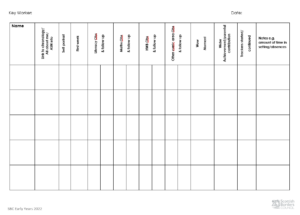Personal Plans
Learning Journeys
What are they?
A learning journey is a record of a child’s learning and development throughout Early Level. A learning journey aims to tell each child’s story, building a unique picture of their achievements and interests. The creation of this must be a collaborative process involving all practitioners, the child, and their family. The learning journey is used to document the significant learning for each child, weaving a progression pathway that develops their present and future potential.
It can be in a book, folder, or electronic format and should enable children to reflect on their progress and learning. It should include the child’s Emerging Literacy Developmental Overviews and trackers, helping to record and track their progress (for SBC Trackers & Developmental Overviews see tabs at the bottom of this page).
Learning journeys or profiles form part of the child’s Personal Plan.
Key messages:
- Clear links are evident between the child’s Care Plan/All About Me and the contents of the learning journey.
- Clear links are evident between the child’s chronology and the contents of the learning journey. See bitesize training ‘Linking the Documents’ and further information on the Personal Plans page.
- Children’s individual achievements are celebrated from within and out with the setting.
- Families are fully involved in understanding their child’s progress; their opinions and knowledge about their child are valued.
- Both families and children contribute to the learning journey.
- The experiences illustrated are developmentally appropriate and tracked.
- Learning journeys must show children’s progress over time and link to the trackers and progression frameworks for literacy and maths.
- Learning journeys document the interactions between the practitioners and the child to evidence progression and enhanced individual learning.
Ways we can do this:
Practitioners use the child’s “All About Me2 information page to influence the provision, so that the children’s interests are catered for, e.g. the child has an interest in cars noted, and there is an observation where the child has been using cars to develop their learning.
Include photos of the child with any adults from partner agencies. Observations are linked to input from the partner agency. Observations reflect entries in the chronology, e.g. a photo of the child with the Pre-School Home-Visiting Teacher (PSHVT) or the child working on the next steps identified by the Speech and Language Therapist (SaLT). For example, the chronology states the child has begun potty training, and the learning journey celebrates their first success.
A section in the learning journey shows children’s achievements, or these are evident throughout the learning journey, e.g. the family sends in photos or a slip that celebrates their child learning to ride a bike or sleeping in their own bed all night for the first time.
Opportunities are given for families to see their child’s learning journey and discuss their child’s learning with their key worker, e.g. learning journeys are sent home regularly or available for families to access online. In addition, families are offered phone calls home to discuss children’s progress.
Children are involved in their learning journey and can access it independently. Families can comment on the child’s learning in the learning journey, e.g. the child is engaged in talking about their learning following observations, sticking in photos, able to ask to have things put in. Feedback sheets are provided when learning journeys are sent home for families to comment on their child’s progress.
Practitioners use the trackers, developmental overviews, and guidance documents to see if the provision and experiences are appropriate developmentally, e.g. supporting subitising, not written calculations.
Linked Areas of Practice
Learning Journeys using SHOWBIE
Care Plans
Child’s Voice
Chronologies
Family Partnerships
Getting It Right For Every Child (GIRFEC)
Making Learning Visible
Medication
Observations
Personal Plans
Sustained Shared Thinking
Tracking, Monitoring & Assessment
Transitions
Tools
Reflecting on Practice
SBC Guidance to support
National Guidance to support
Further Reading to support
Training to support
SBC Early Years training video Learning Journeys as part of a Personal Plan Bitesize:
Learning Journeys on Showbie
Practitioners should ensure that learning journeys include:
- All About Me Information has their position in the family, likes and dislikes, favourite toys, interests and activities.
- Reference to the wellbeing indicators (e.g. emoji stickers).
- Recognition of prior experiences, achievements and learning.
- Observations of significant learning experiences which are clearly dated and recorded.
- Details of how practitioners support individual children to achieve their next steps.
- The child’s voice is recorded, including what they are interested in learning, what they already know, and identifying what they would like to learn next, individually or as a group.
- Information from home community involvement and the child’s wider achievements.
- Practitioner, child and parent or carer evaluations demonstrate an understanding of how well the child is learning, what their next steps are, and where they can apply what they have learned in real situations.
- Progression and development of skills in language and literacy, maths and numeracy, health and wellbeing and other curricular areas, including next steps.
- Individual records and tracking documents across Curriculum for Excellence early level (some settings keep these in the back or in a separate folder).
Spotlight on Practice
Learning Journeys
Natalie’s Childcare, a funded childminder service in Kelso, Scottish Borders, share their approach to Learning Journeys. Also on SBC Spotlight on Practice Portal page.

